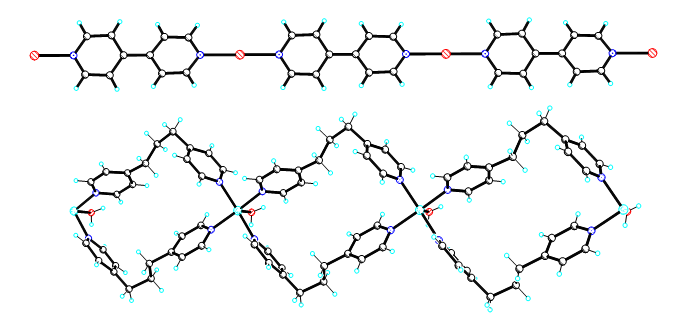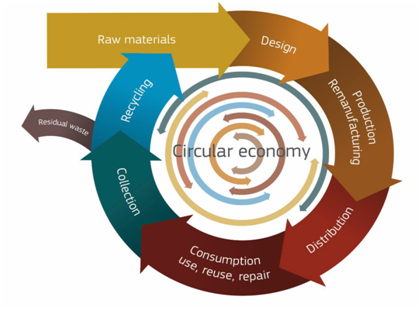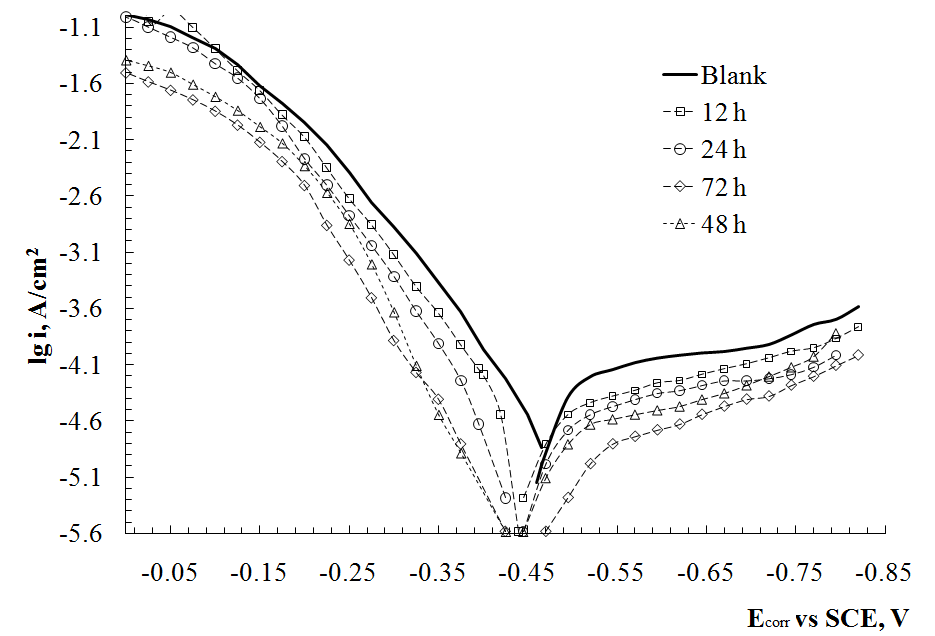Chemistry Journal of Moldova
2019 Volume 14, no.1
Author(s):
Field: Physical chemistry and chemical physics
Type: Research paper
Issue: 2019 Volume 14, no.1
Pages: 98-106
Nur Nadira Hazani, Yusairie Mohd, Sheikh Ahmad Izaddin Sheikh Mohd Ghazali, Nur Nadia Dzulkifli
Field: Physical chemistry and chemical physics
Type: Research paper
Issue: 2019 Volume 14, no.1
Pages: 98-106
Full Text (PDF): Download
Abstract (PDF)
Graphical Abstract: The inhibitive effects of 2-acetylpyridine 4-ethyl-3-thiosemicarbazone (HAcETSc) and dichlorophenyltin(IV) 2-acetylpyridine 4-ethyl-3-thiosemicarbazone (Sn(HAcETSc)PhenCl2) for mild steel in 1 M HCl solution at different concentrations were investigated using electrochemical measurements and scanning electron microscopy analysis. The result of electrochemical measurement found that the inhibition efficiency increased with inhibitors’ concentration. Moreover, it was shown that that Sn(HAcETSc)PhenCl2 had a better inhibitive effect than HAcETSc.

Downloads: 310
Author(s):
Field: Supramolecular chemistry
Type: Research paper
Issue: 2019 Volume 14, no.1
Pages: 120-127
Aliona Vitiu
Field: Supramolecular chemistry
Type: Research paper
Issue: 2019 Volume 14, no.1
Pages: 120-127
Full Text (PDF): Download
Abstract (PDF)
Graphical Abstract: Two new 1D coordination polymers based on octahedral Fe(II) and square-pyramidal Cu(II) complexes and N,N'-bipyridine-type ligands were synthesized by slow evaporation method. The compounds with the formula {(bpyH2)•[Fe(bpy)2(H2O)2(SO4)2]•2(H2O)}n and {[Cu(bpp)2(H2O)]•(BF4)2•dmf•0.75(H2O)}n, (where bpy= 4,4'-bipyridine and bpp= 1,3-bis(4-pyridyl)propane, dmf= N,N-dimethylformamide) were characterized by thermal analysis, FT-IR spectroscopy and single crystal X-ray diffraction method.

Graphical Abstract: Two new 1D coordination polymers based on octahedral Fe(II) and square-pyramidal Cu(II) complexes and N,N'-bipyridine-type ligands were synthesized by slow evaporation method. The compounds with the formula {(bpyH2)•[Fe(bpy)2(H2O)2(SO4)2]•2(H2O)}n and {[Cu(bpp)2(H2O)]•(BF4)2•dmf•0.75(H2O)}n, (where bpy= 4,4'-bipyridine and bpp= 1,3-bis(4-pyridyl)propane, dmf= N,N-dimethylformamide) were characterized by thermal analysis, FT-IR spectroscopy and single crystal X-ray diffraction method.

Downloads: 224
Author(s):
Field: Physical chemistry and chemical physics
Type: Research paper
Issue: 2019 Volume 14, no.1
Pages: 107-119
Yuri Mirgorod, Alexander Chekadanov, Tatiana Dolenko
Field: Physical chemistry and chemical physics
Type: Research paper
Issue: 2019 Volume 14, no.1
Pages: 107-119
Full Text (PDF): Download
Abstract (PDF)
Graphical Abstract: Aqueous micellar solutions of sodium dodecyl sulphate were investigated using X-ray scattering technique by a model-independent approach and dynamic light scattering in the concentration range 0.008 – 0.1 M. The obtained results are discussed in the framework of the concept of polyamorphous transition between ensembles of water clusters of low and high density levels. Polyamorphous transition accompanies the formation of dual structures of contact and separated by water micelles with different rates of diffusion.

Graphical Abstract: Aqueous micellar solutions of sodium dodecyl sulphate were investigated using X-ray scattering technique by a model-independent approach and dynamic light scattering in the concentration range 0.008 – 0.1 M. The obtained results are discussed in the framework of the concept of polyamorphous transition between ensembles of water clusters of low and high density levels. Polyamorphous transition accompanies the formation of dual structures of contact and separated by water micelles with different rates of diffusion.

Downloads: 226
Author(s):
Field: Industrial chemistry
Type: Invited paper
Issue: 2019 Volume 14, no.1
Pages: 32-46
Stefano Ubaldini, Daniela Guglietta, Francesca Trapasso, Serena Carloni, Daniele Passeri, Adalgisa Scotti
Field: Industrial chemistry
Type: Invited paper
Issue: 2019 Volume 14, no.1
Pages: 32-46
Full Text (PDF): Download
Graphical Abstract: This paper presents an overview of the various innovative methodologies used in the recovery of valuable metals and critical raw materials from secondary sources. The review also highlights the used varieties of application on large scale in real situations and hopes to provide insights into valorization of spent sources.

Downloads: 153
Author(s):
Field: Ecological chemistry
Type: Research paper
Issue: 2019 Volume 14, no.1
Pages: 61-67
Gheorghe Duca, Aliona Mereuta, Natalia Velisco, Claudiu Tanaselia, Tatiana Mitina
Field: Ecological chemistry
Type: Research paper
Issue: 2019 Volume 14, no.1
Pages: 61-67
Full Text (PDF): Download
Abstract (PDF)
Graphical Abstract: This study presents an assessment of water quality of Prut River using the Water Quality Index (WQI), calculated according to the weighted arithmetic water quality index method. The obtained results show that the water of Prut River may be classified according to WQI as good water quality of grade B for sampling points Sculeni and Cislita-Prut villages, and very poor water quality of grade D collected in the sampling point Criva village.

Downloads: 174
Author(s):
Field: Ecological chemistry
Type: Research paper
Issue: 2019 Volume 14, no.1
Pages: 47-53
Serghei Travin, Gheorghe Duca, Viorica Gladchi
Field: Ecological chemistry
Type: Research paper
Issue: 2019 Volume 14, no.1
Pages: 47-53
Full Text (PDF): Download
Graphical Abstract: This study presents an assessment of water quality of Prut River using the Water Quality Index (WQI), calculated according to the weighted arithmetic water quality index method. The obtained results show that the water of Prut River may be classified according to WQI as good water quality of grade B for sampling points Sculeni and Cislita-Prut villages, and very poor water quality of grade D collected in the sampling point Criva village.


Downloads: 104
Author(s):
Field: Organic chemistry
Type: Research paper
Issue: 2019 Volume 14, no.1
Pages: 68-76
Emmy Yuanita, Harno Dwi Pranowo, Mustofa Mustofa, Respati Tri Swasono, Jufrizal Syahri, Jumina Jumina
Field: Organic chemistry
Type: Research paper
Issue: 2019 Volume 14, no.1
Pages: 68-76
Full Text (PDF): Download
Abstract (PDF)
Graphical Abstract: In this study, the chloro-substituted hydroxyxanthones were prepared by cyclodehydration of acid derivatives and substituted phenol in the presence of Eaton reagent, followed by halogenations step to electrophilic substitution of chlorine in a moderate yield. The in vitro anticancer activity study on various cell lines revealed that the chloro functional group increases the anticancer activity of the hydroxyxanthone derivatives. The molecular docking study showed that there was a binding interaction between chloro-hydroxyxanthone and the amino acid residues such as Asp810, Cys809, Ile789, His790, and Leu644 of protein tyrosine kinase receptor.

Graphical Abstract: In this study, the chloro-substituted hydroxyxanthones were prepared by cyclodehydration of acid derivatives and substituted phenol in the presence of Eaton reagent, followed by halogenations step to electrophilic substitution of chlorine in a moderate yield. The in vitro anticancer activity study on various cell lines revealed that the chloro functional group increases the anticancer activity of the hydroxyxanthone derivatives. The molecular docking study showed that there was a binding interaction between chloro-hydroxyxanthone and the amino acid residues such as Asp810, Cys809, Ile789, His790, and Leu644 of protein tyrosine kinase receptor.

Downloads: 455
Author(s):
Field: Physical chemistry and chemical physics
Type: Research paper
Issue: 2019 Volume 14, no.1
Pages: 88-97
Ion Arsene, Natalia Gorinchioy
Field: Physical chemistry and chemical physics
Type: Research paper
Issue: 2019 Volume 14, no.1
Pages: 88-97
Full Text (PDF): Download
Abstract (PDF)
Graphical Abstract: The reaction cycle of H2O2 decomposition and O2 generation catalyzed by Fenton reagent was studied using density functional theory calculations. A four-stage mechanism for the oxygen production and the Fe2+ regeneration in the Fenton reaction is proposed based on the obtained results. It is shown that the O-O bond cleavage of coordinated H2O2at the first step of reaction does not lead to a free HO● radical. Instead, a highly reactive intermediate [FeIV(H2O)4(OH)2]2+ with two HO● radicals “trapped” in the complex is formed. The result of the next two reaction steps is the formation of the two HO2● radicals which can react on the triplet energy surface in order to produce O2 and a H2O2.

Downloads: 195
Author(s):
Field: Ecological chemistry
Type: Research paper
Issue: 2019 Volume 14, no.1
Pages: 54-60
Chidi Edbert Duru
Field: Ecological chemistry
Type: Research paper
Issue: 2019 Volume 14, no.1
Pages: 54-60
Full Text (PDF): Download
Graphical Abstract: Toxic heavy metals within a reclaimed section of the Orji mechanic village in Nigeria were determined using X-ray fluorescence and atomic adsorption spectrophotometric methods. The data were analyzed using geo-statistical techniques. Results showed that the soil was strongly contaminated by lead, and extremely contaminated by cadmium at some of the sampling points. The activities at the mechanic village in this area significantly affected the accumulation of these heavy metals and immediate soil remediation has been recommended.


Downloads: 93
Author(s):
Field: Physical chemistry and chemical physics
Type: Research paper
Issue: 2019 Volume 14, no.1
Pages: 77-87
Viktoria Vorobyova, Margarita Skіba
Field: Physical chemistry and chemical physics
Type: Research paper
Issue: 2019 Volume 14, no.1
Pages: 77-87
Full Text (PDF): Download
Graphical Abstract: The protection performance of self-assembled layers (SALs) formed by apricot cake extract (ACE) on the surface of steel has been studied. It was revealed that the protection ability of the SALs is determined by the time of film formation on the steel surface. The maximal corrosion inhibition efficiency (about 93%) was obtained after 48 h process of film formation in the vapour phase of the apricot cake extract. The results of the electrochemical analysis revealed that the ACE modified steel showed better corrosion protection in conditions of periodic condensation of moisture.

protection in conditions of periodic condensation of moisture.

protection in conditions of periodic condensation of moisture.
Downloads: 121






